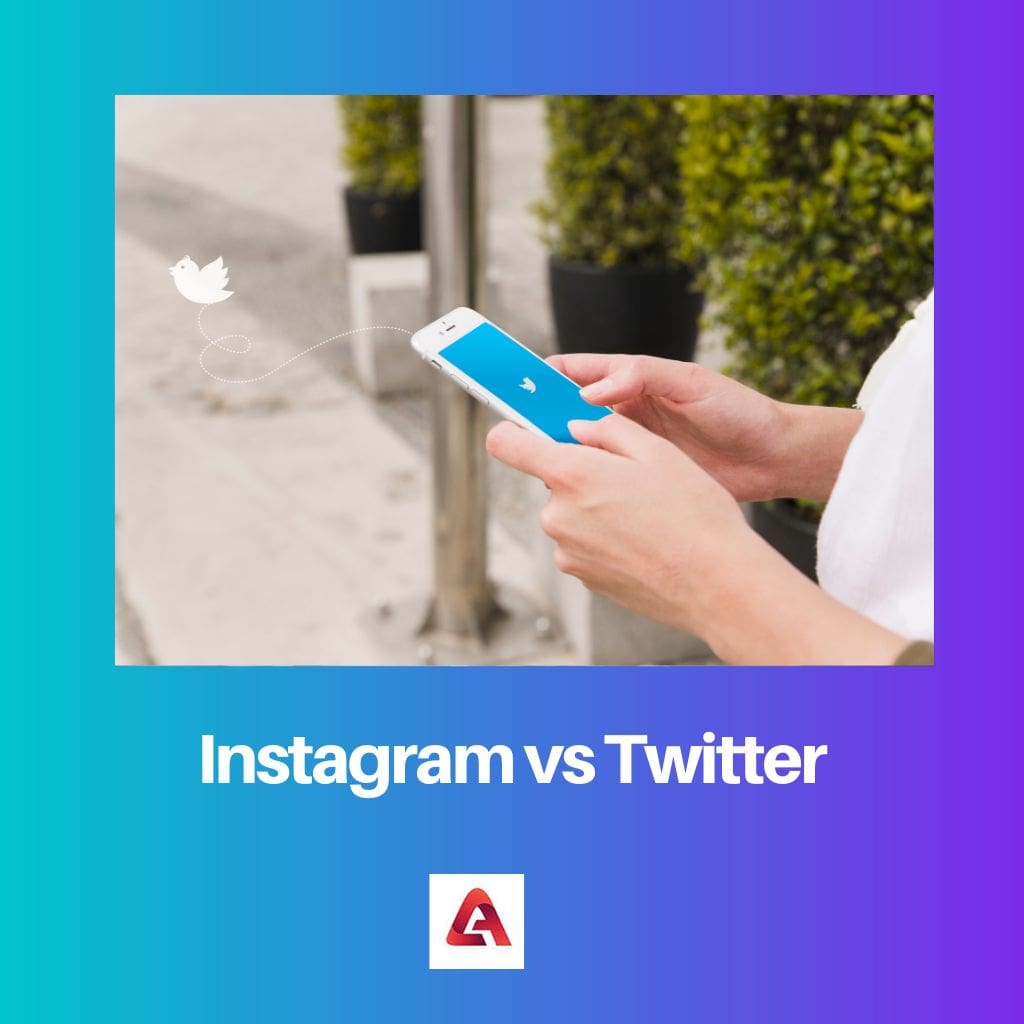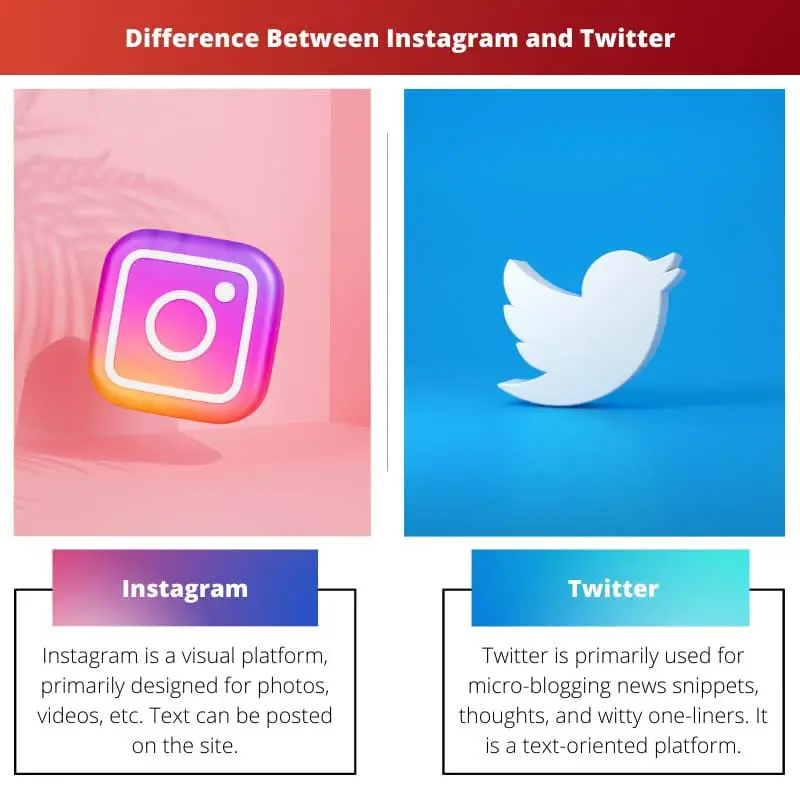Instagram focuses on visual content sharing, emphasizing images and short videos, fostering a highly visual and engaging experience.Twitter, on the other hand, thrives on concise, real-time communication through short text-based messages called tweets, fostering public discourse, news dissemination, and networking.
Key Takeaways
- Instagram is a photo and video-sharing platform, while Twitter is a microblogging site for sharing short messages.
- Instagram focuses on visual content, while Twitter is text-based.
- Instagram is more popular among younger audiences, while Twitter is used more by journalists, politicians, and celebrities.
Instagram vs. Twitter
Twitter is a more text-oriented social media platform with a character limit of 280 characters. This platform is famous for its genuine information about current world situations. Instagram is considered an entertainment social media platform with more focus on videos.

Comparison Table
| Feature | ||
|---|---|---|
| Focus | Visual content: Primarily focuses on sharing photos and videos. | Short-form text: Primarily focuses on sharing text messages (tweets) with a character limit (currently 280 characters). |
| Content type | Photos, videos, stories, live videos, reels (short video clips with music and effects). | Text messages (tweets), images, videos, polls, threads (connected series of tweets). |
| Length of content | Varies depending on the format (photos, videos, live videos) but longer than Twitter. | Limited to 280 characters per tweet. |
| Engagement | Primarily through likes, comments, shares, and direct messages (DMs). | Primarily through likes, retweets, replies, and mentions (using the “@” symbol). |
| Audience | Typically younger demographics, with a focus on personal life, aesthetics, and lifestyle. | Diverse demographics, with a focus on news, current events, opinions, and discussions. |
| Strengths | – Visually engaging and interactive. <br> – Strong platform for building brand awareness and showcasing products/services visually. | – Real-time communication and news updates. <br> – Open discussions and interaction with a wider audience. |
| Weaknesses | – Can be superficial and less informative than text-based platforms. <br> – Emphasis on carefully curated content can create unrealistic portrayals. | – Limited character count can restrict complex ideas and limit depth of expression. <br> – Prone to negativity and rapid spread of misinformation. |
| Examples of use | Sharing travel photos, food pictures, product promotions, stories about daily life, connecting with friends. | Following news channels, sharing opinions on current events, engaging in discussions with public figures, participating in trends and hashtags. |
What is Instagram?
Instagram is a popular social media platform renowned for its focus on visual content sharing, community engagement, and storytelling through images and short videos. Acquired by Facebook in 2012, Instagram has evolved from a simple photo-sharing app to a multifaceted platform with various features catering to diverse user interests.
Visual Content Sharing
At its core, Instagram revolves around the sharing of visual content. Users can upload photos and videos from their mobile devices, apply filters, add captions, and share them with their followers or the public. The platform’s emphasis on high-quality visuals encourages creativity and self-expression, making it a preferred choice for photographers, artists, influencers, and brands alike.
Community Engagement
Instagram fosters a sense of community through likes, comments, and direct messaging, enabling users to interact with each other’s content and build connections. Features such as Stories, Live, and IGTV provide additional avenues for real-time engagement, allowing users to share moments, host live broadcasts, and create longer-form video content to connect with their audience on a deeper level.
Storytelling and Brand Marketing
With its visually immersive format, Instagram has become a powerful tool for storytelling and brand marketing. Businesses leverage the platform to showcase products, engage with customers, and cultivate a distinct brand identity. Influencers and content creators collaborate with brands to promote products and services, leveraging their follower base to drive engagement and sales.
Ecosystem and Monetization
Instagram is part of the broader Facebook ecosystem, allowing for seamless integration with other platforms and advertising opportunities. As of recent years, Instagram has introduced various monetization features such as shoppable posts, branded content partnerships, and the Instagram Partner Program, enabling creators and businesses to monetize their presence on the platform.

What is Twitter?
Twitter is a widely-used social media platform renowned for its real-time, concise communication through short text-based messages known as tweets. Launched in 2006, Twitter has become a prominent platform for news dissemination, public discourse, networking, and content sharing, with millions of users worldwide engaging in conversations across various topics and interests.
Real-Time Communication
Twitter facilitates instant communication through tweets, which are limited to 280 characters (previously 140 characters). This constraint encourages brevity and conciseness, making Twitter ideal for sharing quick updates, thoughts, opinions, and reactions in real-time. Users can engage with tweets by liking, retweeting, or replying, fostering dynamic conversations and interactions.
News Dissemination and Public Discourse
Twitter serves as a vital platform for news organizations, journalists, politicians, and individuals to share and consume news and information rapidly. Its real-time nature enables users to stay updated on current events, trending topics, and breaking news as they unfold. Hashtags play a crucial role in organizing discussions around specific themes or events, facilitating public discourse and activism on a global scale.
Networking and Community Building
Beyond news and public discourse, Twitter facilitates networking and community building by connecting users with shared interests, professions, or affiliations. Users can follow accounts relevant to their interests, engage with like-minded individuals, participate in Twitter chats, and join communities centered around specific topics or hashtags. This fosters collaboration, knowledge sharing, and relationship building across diverse communities.
Multimedia Content and Features
While Twitter’s hallmark is its text-based communication, the platform also supports multimedia content, including photos, videos, and GIFs. Features such as Twitter Polls, Threads (series of connected tweets), Moments (curated collections of tweets), and Spaces (audio-based conversations) enhance the user experience, providing avenues for interactive content creation and consumption.

Main Differences Between Instagram and Twitter
- Content Format:
- Instagram primarily focuses on visual content sharing through photos, videos, Stories, and Reels.
- Twitter revolves around concise text-based messages (tweets) limited to 280 characters, although it also supports multimedia content like photos and videos.
- Communication Style:
- Instagram emphasizes storytelling and engagement through visual content, fostering a more immersive and expressive user experience.
- Twitter prioritizes real-time communication, news dissemination, and public discourse through short, succinct messages, encouraging quick updates and conversations.
- Audience and Use Cases:
- Instagram attracts users seeking visual inspiration, personal expression, brand engagement, and content discovery, making it popular among photographers, artists, influencers, and brands.
- Twitter appeals to individuals interested in real-time news, public discussions, networking, and community engagement, catering to journalists, politicians, professionals, activists, and general users seeking rapid information exchange.
- Engagement Features:
- Instagram offers engagement features like likes, comments, direct messages, and live video streaming, enhancing user interaction and community building.
- Twitter provides engagement features such as likes, retweets, replies, hashtags, and Twitter chats, facilitating conversations, amplifying content reach, and organizing discussions around specific topics.
- Content Longevity and Discovery:
- Instagram’s content tends to have a longer lifespan due to its visual nature, with posts remaining visible on user profiles and explore pages, enabling content discovery over time.
- Twitter’s content moves rapidly through users’ feeds, with tweets having a shorter lifespan as new updates push older ones down the timeline, making content discovery more immediate but fleeting.





